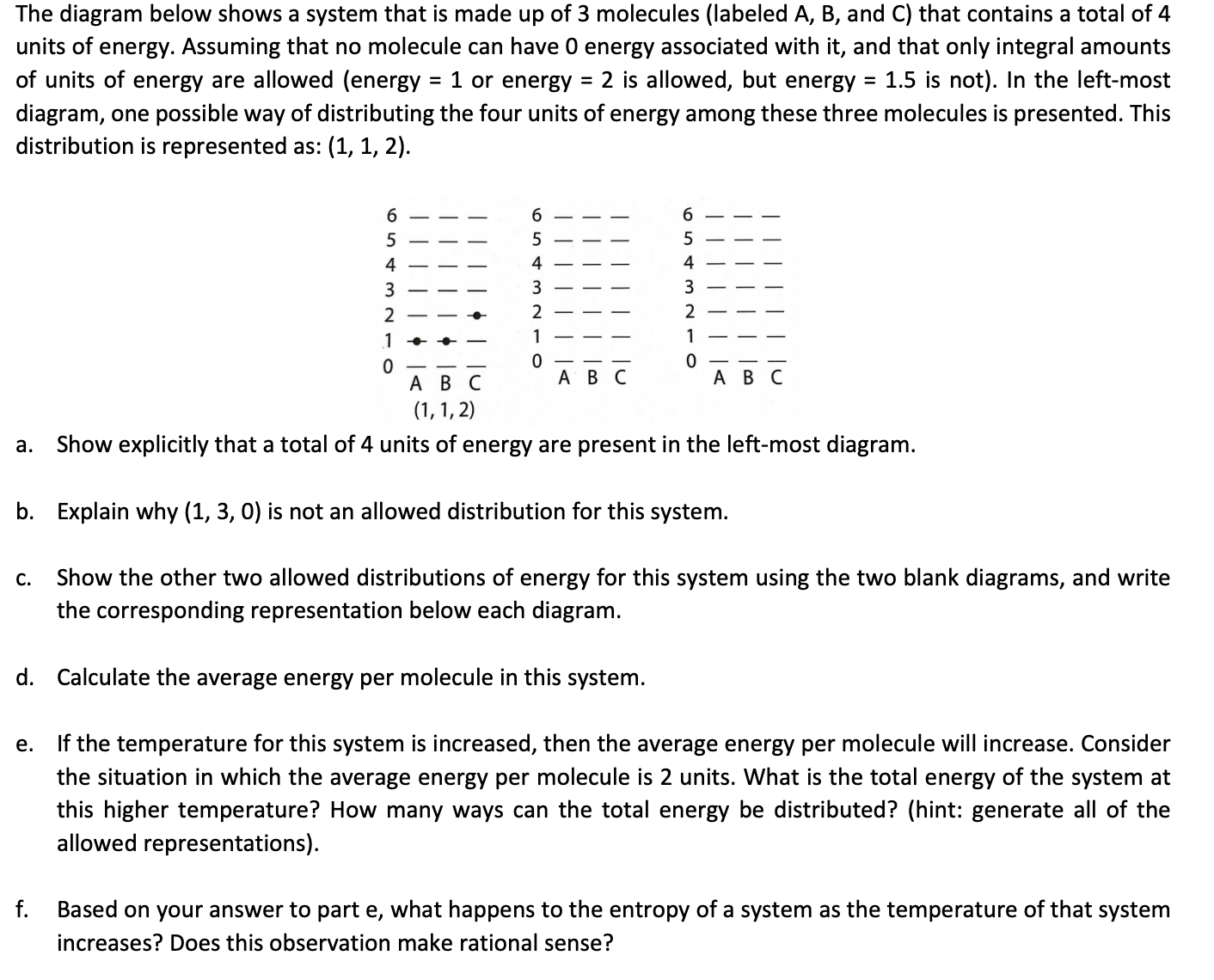The diagram below shows a system that is made up of 3 molecules (labeled A, B, and C) that contains a total of 4 units of energy. Assuming that no molecule can have 0 energy associated with it, and that only integral amounts of units of energy are allowed (energy = 1 or energy = 2 is allowed, but energy = 1.5 is not). In the left-most diagram, one possible way of distributing the four units of energy among these three molecules is presented. This distribution is represented as: (1, 1, 2). %3D 6 SEE 6 5 4 4 4 3 3 3 2 2 1 1 1 A B C AB C АВС (1, 1, 2) a. Show explicitly that a total of 4 units of energy are present in the left-most diagram. b. Explain why (1, 3, 0) is not an allowed distribution for this system. Show the other two allowed distributions of energy for this system using the two blank diagrams, and write the corresponding representation below each diagram. С.
The diagram below shows a system that is made up of 3 molecules (labeled A, B, and C) that contains a total of 4 units of energy. Assuming that no molecule can have 0 energy associated with it, and that only integral amounts of units of energy are allowed (energy = 1 or energy = 2 is allowed, but energy = 1.5 is not). In the left-most diagram, one possible way of distributing the four units of energy among these three molecules is presented. This distribution is represented as: (1, 1, 2). %3D 6 SEE 6 5 4 4 4 3 3 3 2 2 1 1 1 A B C AB C АВС (1, 1, 2) a. Show explicitly that a total of 4 units of energy are present in the left-most diagram. b. Explain why (1, 3, 0) is not an allowed distribution for this system. Show the other two allowed distributions of energy for this system using the two blank diagrams, and write the corresponding representation below each diagram. С.
Chemistry: The Molecular Science
5th Edition
ISBN:9781285199047
Author:John W. Moore, Conrad L. Stanitski
Publisher:John W. Moore, Conrad L. Stanitski
Chapter16: Thermodynamics: Directionality Of Chemical Reactions
Section: Chapter Questions
Problem 16.CCP
Related questions
Question

Transcribed Image Text:The diagram below shows a system that is made up of 3 molecules (labeled A, B, and C) that contains a total of 4
units of energy. Assuming that no molecule can have 0 energy associated with it, and that only integral amounts
of units of energy are allowed (energy = 1 or energy = 2 is allowed, but energy = 1.5 is not). In the left-most
diagram, one possible way of distributing the four units of energy among these three molecules is presented. This
distribution is represented as: (1, 1, 2).
%3D
6
SEE
6
5
4
4
4
3
3
3
2
2
1
1
1
A B C
AB C
АВС
(1, 1, 2)
a. Show explicitly that a total of 4 units of energy are present in the left-most diagram.
b. Explain why (1, 3, 0) is not an allowed distribution for this system.
Show the other two allowed distributions of energy for this system using the two blank diagrams, and write
the corresponding representation below each diagram.
С.
Expert Solution
This question has been solved!
Explore an expertly crafted, step-by-step solution for a thorough understanding of key concepts.
This is a popular solution!
Trending now
This is a popular solution!
Step by step
Solved in 2 steps with 2 images

Knowledge Booster
Learn more about
Need a deep-dive on the concept behind this application? Look no further. Learn more about this topic, chemistry and related others by exploring similar questions and additional content below.Recommended textbooks for you

Chemistry: The Molecular Science
Chemistry
ISBN:
9781285199047
Author:
John W. Moore, Conrad L. Stanitski
Publisher:
Cengage Learning

Physical Chemistry
Chemistry
ISBN:
9781133958437
Author:
Ball, David W. (david Warren), BAER, Tomas
Publisher:
Wadsworth Cengage Learning,

General Chemistry - Standalone book (MindTap Cour…
Chemistry
ISBN:
9781305580343
Author:
Steven D. Gammon, Ebbing, Darrell Ebbing, Steven D., Darrell; Gammon, Darrell Ebbing; Steven D. Gammon, Darrell D.; Gammon, Ebbing; Steven D. Gammon; Darrell
Publisher:
Cengage Learning

Chemistry: The Molecular Science
Chemistry
ISBN:
9781285199047
Author:
John W. Moore, Conrad L. Stanitski
Publisher:
Cengage Learning

Physical Chemistry
Chemistry
ISBN:
9781133958437
Author:
Ball, David W. (david Warren), BAER, Tomas
Publisher:
Wadsworth Cengage Learning,

General Chemistry - Standalone book (MindTap Cour…
Chemistry
ISBN:
9781305580343
Author:
Steven D. Gammon, Ebbing, Darrell Ebbing, Steven D., Darrell; Gammon, Darrell Ebbing; Steven D. Gammon, Darrell D.; Gammon, Ebbing; Steven D. Gammon; Darrell
Publisher:
Cengage Learning

Chemistry by OpenStax (2015-05-04)
Chemistry
ISBN:
9781938168390
Author:
Klaus Theopold, Richard H Langley, Paul Flowers, William R. Robinson, Mark Blaser
Publisher:
OpenStax

Introductory Chemistry: A Foundation
Chemistry
ISBN:
9781337399425
Author:
Steven S. Zumdahl, Donald J. DeCoste
Publisher:
Cengage Learning

Chemistry: An Atoms First Approach
Chemistry
ISBN:
9781305079243
Author:
Steven S. Zumdahl, Susan A. Zumdahl
Publisher:
Cengage Learning